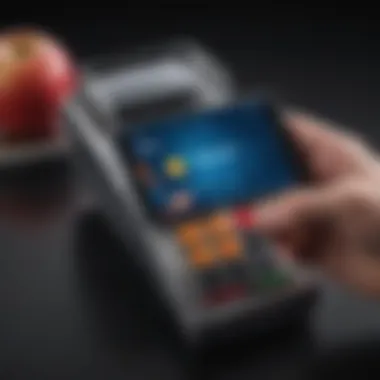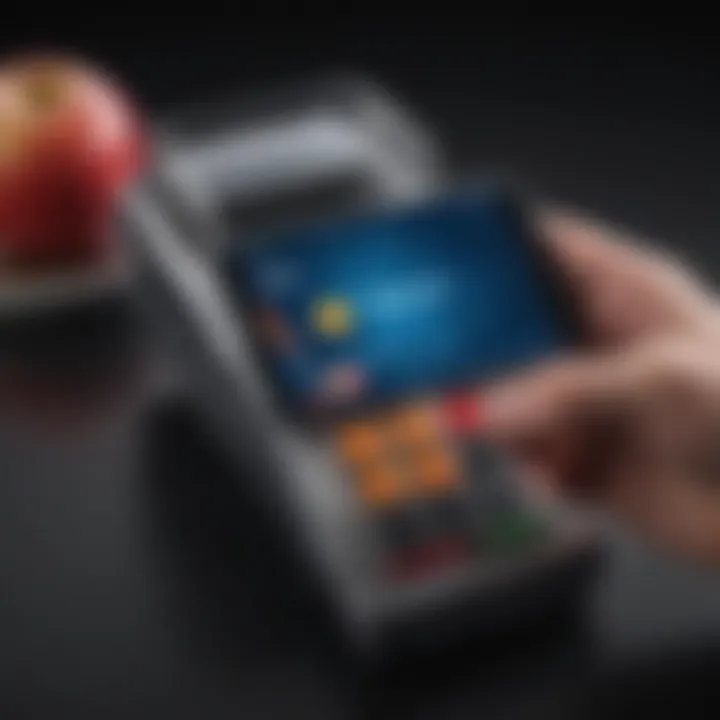Banks That Accept Apple Pay: A Detailed Guide


Intro
In an era where digital transactions are becoming the rule rather than the exception, Apple Pay stands as a cornerstone of mobile payment options. It empowers users not only with convenience but also adds a layer of security in their daily financial dealings. As more financial institutions recognize the growing demand for seamless payment solutions, understanding which banks accept Apple Pay becomes a necessity for the modern consumer.
This overview will peel back the layers, revealing the landscape of banks that integrate Apple Pay, the benefits linked to this payment method, and the technical integration that underpins it. Furthermore, it will examine the implications for user experience and security, ensuring that readers are well-informed when choosing a bank to partner with in their personal finance journeys. Ultimately, the aim is to equip customers with the knowledge needed to deftly navigate their banking options.
As we embark on this exploration, we will break down the features and functionalities of Apple Pay, dissect the customer experience, and assess the competitive landscape. We'll also look into the vital factors that influence the choice of banks and other financial institutions that have adopted this mobile payment solution.
The journey promises to enhance your understanding of a payment technology that is redefining how we interact with our finances in this fast-paced digital age.
Prolusion to Apple Pay
In the modern financial landscape, digital payment solutions have become more than just a convenience; they are essential tools for managing everyday transactions. Among these options, Apple Pay stands out. This section introduces Apple Pay, elucidating its significance in today's banking ecosystem and its role in reshaping how consumers interact with their financial institutions.
Understanding Apple Pay is vital because it symbolizes a shift towards a cashless society, aligning with various trends emphasizing fast, secure, and easy payment methods. Integrating this platform with banking services offers consumers the ability to transact effortlessly with the tap of a finger, subsequently enhancing customer experience. More importantly, as businesses and banks embrace this technology, users benefit not only from convenience but also from robust security features largely absent in traditional payment methods.
What is Apple Pay?
Apple Pay is a mobile payment service developed by Apple Inc., designed to facilitate in-person and online transactions. It allows users to make purchases using their iPhones, iPads, and Apple Watches by linking their debit and credit cards directly to their devices. To sum it up, it’s seamlessly tying together the world of banking and technology.
When a user initiates a payment, the transaction is processed securely via Near Field Communication (NFC), meaning one doesn’t need to fumble over cash or cards at the checkout. Instead, Apple Pay creates a unique transaction code for each purchase, thus protecting users' card details. As mobile wallets like Apple Pay gain traction, they shift the dynamics of how we think about money – making our pockets lighter and our purchases faster.
History and Evolution of Apple Pay
Launched in October 2014, Apple Pay marked Apple's first foray into mobile payments. It stemmed from a larger trend of digital payments gaining popularity, reflecting the demands of tech-savvy consumers. Back then, the concept of paying with a phone seemed futuristic, even a bit gimmicky to some. However, Apple capitalized on its ecosystem by making the transition smooth for users already engaged in its platform.
The early adoption phase was critical. Apple secured partnerships with major banks and payment processors to ensure widespread acceptance across various retailers, a move that contributed strongly to its hefty user base. Over the years, Apple Pay introduced enhancements like support for in-app purchases, subscriptions, and even a broader range of card issuers.
Significant milestones included expanding internationally in countries like Canada and the UK, positioning itself as a global contender in the digital payment arena. As time progressed, the feature set grew, includes things like peer-to-peer payments and even the ability to store tickets and boarding passes.
Overall, Apple Pay isn’t just about payment; it signifies an evolution in consumer behavior, demonstrating a clear shift toward a more digital-centric approach to money management.
"Apple Pay serves as a forerunner in the mobile payments evolution, shaping how we perceive currency and transactions in our daily lives."
Importance of Mobile Payment Solutions
In today’s fast-paced world, mobile payment solutions have carved out a significant niche in the financial services landscape. The increasing ubiquity of smartphones combined with the rising consumer demand for convenience has made these solutions not just a trend, but a revolution. For institutions such as banks, integrating mobile payment options like Apple Pay is not merely a value-added service but an essential element of their service arsenal.
The Shift Towards Digital Transactions
As traditional payment methods continue to wane in prominence, we are witnessing a clear shift towards digital transactions. This transformation is underpinned by several factors:
- Convenience and Speed: Mobile payments allow users to make transactions with just a few taps, eliminating the need to rummage through wallets for cash or cards. Whether it's at a local cafe or an online retail platform, the swiftness of mobile payments enhances the overall customer experience.
- Contactless Features: Particularly in a post-pandemic society, the emphasis on contactless payment options has grown significantly. Consumers are keen on solutions that reduce physical contact, making Apple Pay - with its NFC technology - a favored choice.
- Integration with Other Applications: Apple Pay seamlessly integrates with numerous apps. Customers can purchase airline tickets, pay for rideshares, and even shop online, all from their mobile devices. This level of integration illustrates convenience in managing finances on-the-go.
“The future of commerce is undoubtedly tied to how quickly and effectively we can adopt and adapt to mobile payment solutions.”
Consumer Preferences in Payment Methods
Consumer behavior is a pivotal force shaping the adoption of mobile payment technologies. Recent surveys highlight a few striking preferences:
- Increased Trust: Consumers have become more comfortable with digital payments, especially as they see technology maturing and providers enhancing security. With Apple Pay’s robust security features, individuals are more likely to adopt it compared to lesser-known platforms.
- Desire for Flexibility: Consumers appreciate having multiple payment options at their fingertips. With Apple Pay, users can send money to friends or make purchases in stores, fostering a sense of flexibility that traditional banking methods often fail to offer.
- Preference for Loyalty Programs: As more users utilize mobile payments, banks and merchants have responded by linking loyalty rewards to mobile transactions, making Apple Pay not just a way to pay, but a means to earn rewards. Users favor platforms that align with their spending habits while rewarding their loyalty.
Major Banks Offering Apple Pay
Understanding which banks support Apple Pay is key to making the most of this mobile payment system. As financial transactions continue their migration towards digital formats, the role of major banks becomes paramount. These institutions offer seamless integration of Apple Pay, increasing convenience for users while ensuring that transactions remain secure and efficient. It’s not just about using an app; it’s about aligning with institutions that grasp the importance of modern banking solutions. In this section, we dig into the notable players that have jumped on the Apple Pay bandwagon, the implications of this support, and what it means for users.


National Banks and Their Compatibility
National banks, owing to their vast reach and resources, have generally been quick to embrace innovations like Apple Pay. For customers, this means a tangible benefit in being able to pay with a simple tap or glance.
Some of the most recognized names in this space include:
- Bank of America: With a robust app, they enable users to integrate Apple Pay easily. Their extensive ATM network is also compatible.
- Chase: A pioneer in the digital payment landscape, Chase has streamlined its services to ensure that users can access Apple Pay without a hitch.
- Wells Fargo: Known for its secure banking options, Wells Fargo added support for Apple Pay to further ease customer transactions.
These banks are not only integrating Apple Pay but also optimizing experiences around it. For instance, they offer in-depth guides for those unfamiliar with the technology, ensuring users have a clear pathway to using Apple Pay effectively. This proactive approach is significant, as it builds trust among customers who may be hesitant about digital payments.
Credit Unions Supporting Apple Pay
Credit unions differ from national banks in their structure and service focus, but many have stepped up to meet customer demand for mobile payments. They might not have the same market reach, yet they maintain an edge in providing personalized service.
Some credit unions that support Apple Pay include:
- Navy Federal Credit Union: This credit union prioritizes technology while holding strong roots in community service, making it a favorite amongst tech-savvy members.
- Alliant Credit Union: Known for their customer-first approach, Alliant has added Apple Pay to meet the needs of their younger, tech-oriented clientele.
The inclusion of Apple Pay by credit unions illustrates a commitment to meeting customer needs. These institutions often offer lower fees or better interest rates, making their offering of mobile payments all the more attractive. Plus, their community-focused approach often leads to a more personalized experience.
"Adapting to digital payments isn’t just about tech—it’s a shift towards an increasingly sophisticated customer base that values convenience and security."
In summary, both national banks and credit unions are paving the way for a more integrated banking experience with Apple Pay. Whether there's a big corporate institution or a smaller credit union involved, users can see the benefits of this system, shifting habits and expectations alike. Understanding these dynamics not only serves to highlight why you should consider which banks to choose but also encourages deeper engagement with modern banking practices.
Regional Banks Embracing Apple Pay
In today’s tech-savvy world, regional banks are stepping up to the plate by integrating Apple Pay into their systems. This shift reflects a broader trend in the financial industry, where smaller institutions realize the necessity of keeping pace with technological advancements. Regional banks often have a more intimate understanding of their customer base, which allows them to tailor services like Apple Pay to meet specific community needs. This local touch, combined with modern convenience, is setting new standards in customer service and engagement.
Notable Regional Institutions
Many regional banks are not just adopting Apple Pay but are doing so with distinctive flair. For example, Fifth Third Bank, headquartered in Cincinnati, has swiftly embraced Apple Pay, making it easier for customers to manage their finances right at their fingertips. Similarly, PNC Bank has enabled its users to utilize Apple Pay for seamless transactions. Both institutions highlight a commitment to innovation by offering secure and efficient ways for users to make payments.
Another remarkable player is the East Wisconsin Savings Bank. They are not just about traditional banking; they are innovating by allowing customers to use Apple Pay for various transactions, be it online purchases or payments at brick-and-mortar establishments. Such banks underscore a quality approach to banking—combining local service with modern payment technology.
Key Benefits for Customers
The incorporation of Apple Pay by regional banks comes with a host of benefits that enhance user experience.
- Convenience: Users can make payments quickly using their Apple devices, reducing the time spent on transactions.
- Security: Apple Pay incorporates advanced security measures, including encryption and tokenization, ensuring that sensitive information is protected. Customers can transact with peace of mind knowing their data is safeguarded.
- Enhanced Access: Customers who may live in areas with limited banking options can enjoy sophisticated payment solutions without the need for extensive travel.
- Integration with Mobile Banking: Many regional banks that accept Apple Pay also offer robust mobile banking apps, allowing for a one-stop-shop experience where customers can manage their finances seamlessly.
- Loyalty Programs: Some regional banks have tied in Apple Pay with their loyalty programs, making it even more advantageous for customers to use digital payments.
"The integration of Apple Pay into regional banks not only boosts tech accessibility but also aligns banking practices with contemporary consumer behavior, leading to greater customer satisfaction."
In summary, as regional banks embrace Apple Pay, they not only attract a younger, tech-minded clientele but also keep existing customers engaged by providing tools that are both practical and aligned with modern banking trends. As this trend continues to grow, it stands to reason that both the institutions and their clients will reap the benefits.
How to Set Up Apple Pay with Banks
Setting up Apple Pay with your bank can be a game changer, making everyday transactions easier and more secure. The process of adding your bank account to Apple Pay is not only straightforward, but it also enables hassle-free payments at your favorite stores and online platforms. This section will guide you through the steps involved, as well as some considerations to keep in mind while using this technology.
A Step-by-Step Guide
To get started with setting up Apple Pay, it’s essential to have an Apple device that supports the feature. The following steps outline the process:
- Open the Wallet App: On your iPhone or Apple Watch, look for the Wallet app, which is pre-installed. Tap to open it.
- Add a Card: Inside the Wallet app, you’ll see a plus (+) icon at the upper right corner of the screen. Tapping this will initiate the card addition process.
- Choose Your Card Type: You will be given options to add either a credit or debit card. Enter your card details either by typing them manually or by using your device’s camera to scan the card.
- Verification Process: Your bank may require verification of the card. This can involve receiving a code via text message or email, or simply a phone call. Follow the on-screen instructions to complete this step.
- Set Up Apple Pay for Purchases: After successful verification, you will see your new card listed in the Wallet. Here, you can tap on it to set it as your default payment method if you have multiple cards added.
- Start Using Apple Pay: Once everything is set up, you’re ready to make purchases using Apple Pay! Simply hold your device near a compatible card reader and authenticate using Face ID, Touch ID, or your passcode.
By following these easy steps, many people have successfully integrated Apple Pay into their daily lives, enjoying enhanced convenience at their fingertips.


"Using Apple Pay felt like stepping into the future. Just tap and go!" - Anonymous User
Troubleshooting Common Issues
Despite Apple Pay’s user-friendly design, some individuals may encounter issues while setting things up or using the service. Here are some common problems and solutions:
- Card Not Supported: If your bank doesn't support Apple Pay, check directly with your bank for compatibility. Various institutions have made commitments but may not be universally available yet.
- Failed Verification: Ensure that the information you enter matches your bank records. If it still fails, contact your bank for assistance.
- Updates Required: Sometimes, issues can arise if your device is not running the latest software. Make sure your iPhone or Apple Watch is updated to the latest version of iOS or watchOS.
- Location Issues: In some cases, transactions may be declined due to location settings or restrictions set by your bank. Check with your financial institution if you plan to use Apple Pay abroad.
By keeping these tips in mind, users should easily navigate any hiccups in the setup process, solidifying their experience with this premier payment solution.
Security Features of Apple Pay
In a world where security breaches make daily headlines, the importance of robust security features in mobile payment solutions cannot be overstated. Apple Pay stands out not only for its convenience but also for its commitment to safeguarding your financial information. The mobile payment landscape is precarious, and understanding how Apple Pay secures transactions provides users with peace of mind. This section will delve into the encryption methods and authentication processes that ensure your data remains under lock and key.
Encryption and Privacy Measures
When it comes to encryption, Apple Pay employs sophisticated cryptographic techniques to protect user data. Each transaction is secured with a unique transaction code and device-specific number, which means your actual credit card number is never transmitted during the payment process. This separation is crucial; it minimizes the risk of exposing personal information to hackers. Furthermore, Apple utilizes an advanced Secure Element (SE) chip within its devices, creating a fortress around sensitive data.
Moreover, Apple does not retain transaction data after the payment is complete. This design decision reinforces privacy, ensuring that your purchase history is not stored on Apple's servers. As a user, this means that even if a potential breach occurred at a merchant’s point of sale, your sensitive financial details aren’t hanging out there in the open. In essence, the data remains on a need-to-know basis.
"With Apple Pay, it feels like my financial information is not only encrypted, but almost invisible to the outside world—frankly, that’s a crucial factor for me when I decide where to spend."
Authentication Processes
Authentication in Apple Pay takes security several steps further. Users need to verify each transaction using either Face ID, Touch ID, or a secure passcode. This biometric authentication ensures that only the authorized user can make payments, adding another layer of protection. Unlike traditional credit cards, where a stolen card number can lead to unauthorized purchases, Apple Pay’s biometric systems significantly reduce this risk.
Additionally, online shopping is just as secure. When making purchases through apps or websites that accept Apple Pay, users are not required to input their credit card details every time. Instead, the service utilizes a secure tokenization process. It generates a randomized security code specific to each transaction, so even if hackers intercept the communication, what they get is practically useless.
Potential Drawbacks of Using Apple Pay
Considering Apple Pay as a payment option comes with its perks, but it's crucial to also weigh its limitations. As digital wallets gain traction among consumers, it's become increasingly important to understand the potential drawbacks that may arise when using Apple Pay at various banks. These drawbacks could affect user experience, accessibility, and ultimately a person's decision on whether to adopt this technology. Here, we explore some of the more significant concerns that users should be aware of.
Limitations in Availability
One of the more glaring issues with Apple Pay is its limited availability. Although the platform has expanded significantly since it first launched, not all banks have adopted Apple Pay. Some smaller regional banks and credit unions may not support it, which could be a dealbreaker for potential users. For instance, if you primarily bank with a local institution, it’s worth checking if they have integrated Apple Pay into their services.
Moreover, even within banks that offer Apple Pay, certain accounts or cards may not be compatible. For example, prepaid cards or some business accounts might not work with the digital wallet. It's not uncommon for customers to assume their financial institution supports Apple Pay, only to find out later that their specific card does not.
Also, while many retailers in urban areas readily accept Apple Pay, smaller shops or establishments in rural or suburban areas may lag behind in adopting this technology. Hence, while you might enjoy seamless transactions at larger chains, you might find yourself stuck at checkout in a quaint local store if they don’t accept Apple Pay. This creates a level of friction that might tarnish the convenience Apple Pay promises.
"The more pervasive the technology, the more likely it is to encounter points of friction."
Bank-Specific Restrictions
Another hurdle to consider are bank-specific restrictions that could impact the effectiveness of Apple Pay. Even within banks that do support Apple Pay, some may impose restrictions on how much you can spend using the platform. Depending on your banking institution's policies, you might face a cap on transactions made via Apple Pay. This could deter some users who prefer using mobile payments for larger purchases, as they'd have to resort back to traditional payment methods like a debit or credit card.
Additionally, certain promotional offers or rewards programs may not apply when transactions are made through Apple Pay. Some banks link rewards or cash-back incentives to specific cards, and users may find that those benefits do not carry over when making purchases using Apple Pay. It's a perplexing situation that might frustrate users accustomed to maximizing rewards for every transaction.
While the security measures offered by Apple Pay are robust, they can also cause confusion. Some users might not fully understand how to implement and manage security settings within their bank's specific app, leading to insecurity about whether they are protected or if they are using the service correctly. Knowing these kinds of restrictions and limitations before diving into Apple Pay can prevent missteps down the line.
In summary, while Apple Pay offers a convenient and efficient way to handle transactions, users must consider these limitations and restrictions carefully. Being informed can help users make more strategic decisions about adopting Apple Pay for their banking needs.
Customer Experiences and Feedback
Understanding customer experiences and feedback is pivotal in the context of banks that accept Apple Pay. This section sheds light on how users perceive the integration of Apple Pay into their banking routines and the broader implications for financial services. The user experience often dictates how effectively a feature, like Apple Pay, is adopted. Positive feedback can not only enhance customer loyalty but also contribute to the overall reputation of the banking institution.


Moreover, the nuances of customer feedback provide insights into the effectiveness of the integration, including ease of use, transaction speed, and security perceptions. Customers don't just want a smooth payment process; they crave reassurance that their financial data is safe and that any issues will be promptly addressed. Banks that actively listen and adapt based on user reviews often find themselves at a competitive advantage.
User Reviews and Ratings
A significant part of assessing the customer experience hinges on user reviews and ratings. These evaluations often combine ease of use, transaction efficiency, and overall satisfaction with Apple Pay's functionality in a banking context.
- Ease of Use: Many users applaud the convenience Apple Pay offers. For instance, users may express satisfaction over the quick setup process on banking apps, enabling them to add their cards without a hitch.
- Transaction Speed: Reviews often note how swiftly transactions can be completed compared to traditional payment methods. Some users report completing purchases in mere seconds, which certainly adds value to daily transactions.
- Security Features: User reviews often highlight the comfort that comes from Apple Pay's security features. Many see the use of tokenization and biometric security, like Face ID or Touch ID, as strong points that make them feel secure when making bank-related transactions.
However, it's not all rosy. There can also be concerns. Some users might mention glitches in the app or infrequent compatibility issues at point-of-sale terminals, particularly in regions where merchants are still turning the tide toward digital payments. Therefore, these reviews present a dual image: they highlight the strengths of Apple Pay while also indicating areas that may need bank attention.
Case Studies from Various Banks
Examining case studies from various banks that support Apple Pay can provide a clearer picture of real-world applications and outcomes. These case studies illustrate how different institutions adopt Apple Pay, the challenges they face, and the resultant customer feedback.
- Chase Bank: Chase has implemented Apple Pay remarkably well. Customer reviews often point out its seamless integration with the banking app. Users report fewer problems while conducting transactions and express satisfaction with the customer service response when issues arise, feeding the positive customer experience narrative.
- Bank of America: Conversely, some users have shared mixed experiences with Bank of America's Apple Pay integration. While many appreciate the user-friendly interface, complaints about app crashes sporadically appear. This indicates room for improvement on certain technical fronts.
- Capital One: Capital One has seen favorable feedback as well. Customers generally appreciate the impeccable security features, often citing the benefits of biometric authentication. This attention to security seems to have positively influenced overall user perception.
These case studies serve to underline crucial factors, such as responsiveness to feedback and the importance of regular app updates, which can significantly impact overall customer experiences.
Future of Apple Pay in Banking
As we glance into the crystal ball of banking technology, the future of Apple Pay certainly catches the eye. It’s not merely about how people pay today but what lies ahead. The significance of this topic in this article cannot be overstated, with its implications reaching both consumers and financial institutions alike. The metamorphosis we are witnessing in mobile payments reflects a broader shift in how people view and use their financial resources.
When we talk about the future of Apple Pay, we delve into an arena filled with advancements and fresh ideas. One of the pivotal elements is the rise of contactless payments, which have surged in popularity, and not by sheer happenstance.
Technological Innovations on the Horizon
In this digital age, innovation seems to be moving at breakneck speed. Some technological advancements that we can expect to shape the future of Apple Pay include:
- Enhanced Integrations: With further integration into banking apps, the experience for customers will become more seamless. Users might manage everything from their bills to their payment options in one unified application.
- Biometric Security Enhancements: Apple has always put a premium on security. Imagine a future where your identity is confirmed with even more advanced biometric methods, making unauthorized access a relic of the past.
- Blockchain Technology: While this concept is often wrapped up in the world of cryptocurrencies, its application could be far-reaching in payment processing. The use of blockchain could offer faster transaction speeds and heightened transparency, which benefits both users and banks.
These innovations not only optimize the Apple Pay system but also enhance customer satisfaction, fostering trust and usage among a broader audience.
Predicted Trends in Mobile Payments
Examining the trends emerging in the mobile payment space can provide invaluable insight into what the future holds:
- Increased Merchant Adoption: It’s expected that more merchants will jump on the Apple Pay bandwagon. As mobile payments become normalized, stores might invest more into enabling digital payment systems.
- Reinforced Customer Loyalty Programs: Banks might begin to use Apple Pay more effectively as a customer retention tool. Imagine a system where every transaction earns you points or rewards that are even more appealing than traditional systems.
- Focus on Sustainability: As environmental considerations grow in importance, consumers could start shifting towards platforms that promote eco-friendliness. Apple and associated banks might capitalize by implementing practices that underlie sustainability in mobile payments.
The End: Navigating Your Banking Options
In today's fast-paced digital world, understanding your banking options, especially regarding payment technologies like Apple Pay, is crucial. As this article has illustrated, many banks have embraced Apple Pay to offer customers more convenient and secure transaction methods. But this does not come without particular considerations to keep in mind.
First and foremost, the decision to use Apple Pay hinges on a few key elements:
- Compatibility: Not every bank supports Apple Pay. It’s vital to check if your bank has the capability before trying to integrate this service.
- User Experience: The interface and the overall customer experience can vary by institution. Some banks may provide smoother transitions, while others may not prioritize user-friendly platforms.
- Security: Apple Pay prides itself on robust security features; however, it’s important to evaluate how each bank safeguards your information and how that compares to traditional card use.
- Ease of Access: Consider how intuitively you can use Apple Pay within your banking app. Does your bank's mobile app facilitate easy access?
"In a world increasingly dictated by technology, your banking choices should reflect both your lifestyle and your needs."
Is Apple Pay Right for You?
Determining whether Apple Pay is the right fit for your banking habits involves assessing your personal needs and preferences. For instance, if you're someone who frequently makes purchases on-the-go or enjoys the convenience of mobile payments, Apple Pay could be an excellent choice. This platform allows for quick payments with just a tap, saving time during busy days.
However, for individuals who may favor traditional payment methods or have concerns over technology and its reliability, it might not resonate as strongly. It’s also essential to consider the type of purchases you make. If large transactions are the norm, make sure your chosen bank does not impose restrictions on the maximum amount payable via Apple Pay.
Final Considerations
In sum, the blend of convenience and security that Apple Pay offers cannot be overlooked, and with so many banks climbing on board, the choices are plentiful. Yet, not every financial institution will meet your expectations. Look for reviews or feedback from other customers to gauge their experiences.
Moreover, stay alert to technological advancements in the mobile payment landscape. Banks are continuously upgrading their systems to enhance user experience, so it’s prudent to stay informed.
Ultimately, taking the plunge into digital payments should align with your financial goals and tech comfort level. Apple Pay can be a significant asset in your banking toolkit, but doing your homework is key. Think about how this payment method fits into your broader financial picture before making any commitments. Embracing the right banking solution will lead to a smoother, more fulfilling financial journey.



